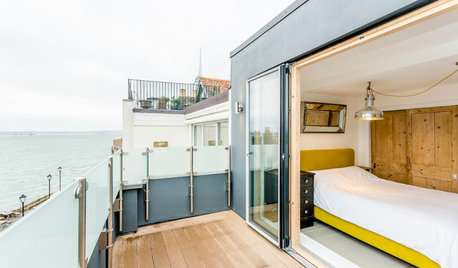Extra insulation and/or radiant barrier, for an attic
joel_bc
17 years ago
Related Stories

FLOORSIs Radiant Heating or Cooling Right for You?
Questions to ask before you go for one of these temperature systems in your floors or walls (yes, walls)
Full Story
REMODELING GUIDESCool Your House (and Costs) With the Right Insulation
Insulation offers one of the best paybacks on your investment in your house. Here are some types to discuss with your contractor
Full Story
GREEN BUILDINGInsulation Basics: Heat, R-Value and the Building Envelope
Learn how heat moves through a home and the materials that can stop it, to make sure your insulation is as effective as you think
Full Story
GREAT HOME PROJECTSHow to Add a Radiant Heat System
Enjoy comfy, consistent temperatures and maybe even energy savings with hydronic heating and cooling
Full Story
MATERIALSInsulation Basics: What to Know About Spray Foam
Learn what exactly spray foam is, the pros and cons of using it and why you shouldn’t mess around with installation
Full Story
GREEN BUILDINGInsulation Basics: Natural and Recycled Materials
Consider sheep’s wool, denim, cork, cellulose and more for an ecofriendly insulation choice
Full Story
GREEN BUILDINGEcofriendly Cool: Insulate With Wool, Cork, Old Denim and More
Learn about the pros and cons of healthier alternatives to fiberglass and foam, and when to consider an insulation switch
Full Story
WINDOW TREATMENTSEasy Green: 9 Low-Cost Ways to Insulate Windows and Doors
Block drafts to boost both warmth and energy savings with these inexpensive but effective insulating strategies
Full Story
GREEN BUILDINGInsulation Basics: Designing for Temperature Extremes in Any Season
Stay comfy during unpredictable weather — and prevent unexpected bills — by efficiently insulating and shading your home
Full Story
ATTICSRoom of the Day: A Bright Attic Conversion
Transforming the attic in this 17th-century house gained its owners a whole new outlook and the chance to switch decor styles
Full Story





rychnc
joel_bcOriginal Author
Related Professionals
Emeryville Solar Energy Systems · Menifee Solar Energy Systems · Voorhees Solar Energy Systems · Berkley Home Builders · Griffith Home Builders · Kaysville Home Builders · Kearns Home Builders · Lomita Home Builders · Columbia Roofing & Gutters · Edison Roofing & Gutters · Joliet Roofing & Gutters · Omaha Roofing & Gutters · Portage Roofing & Gutters · Washington Roofing & Gutters · Westchester Roofing & Guttersrychnc
RCMJr
joel_bcOriginal Author
dallasbill
sweatin_in_texas
mikie_gw
energy_rater_la
mikie_gw
scott2006
fespo
behaviorkelton
mikie_gw
greif
evans
mikie_gw
rjoh878646
mikie_gw
rjoh878646
islandpete
woodinvirginia
greenthumbs08
garymunson-2008
zl700
Saskia Madison
Windows on Washington Ltd